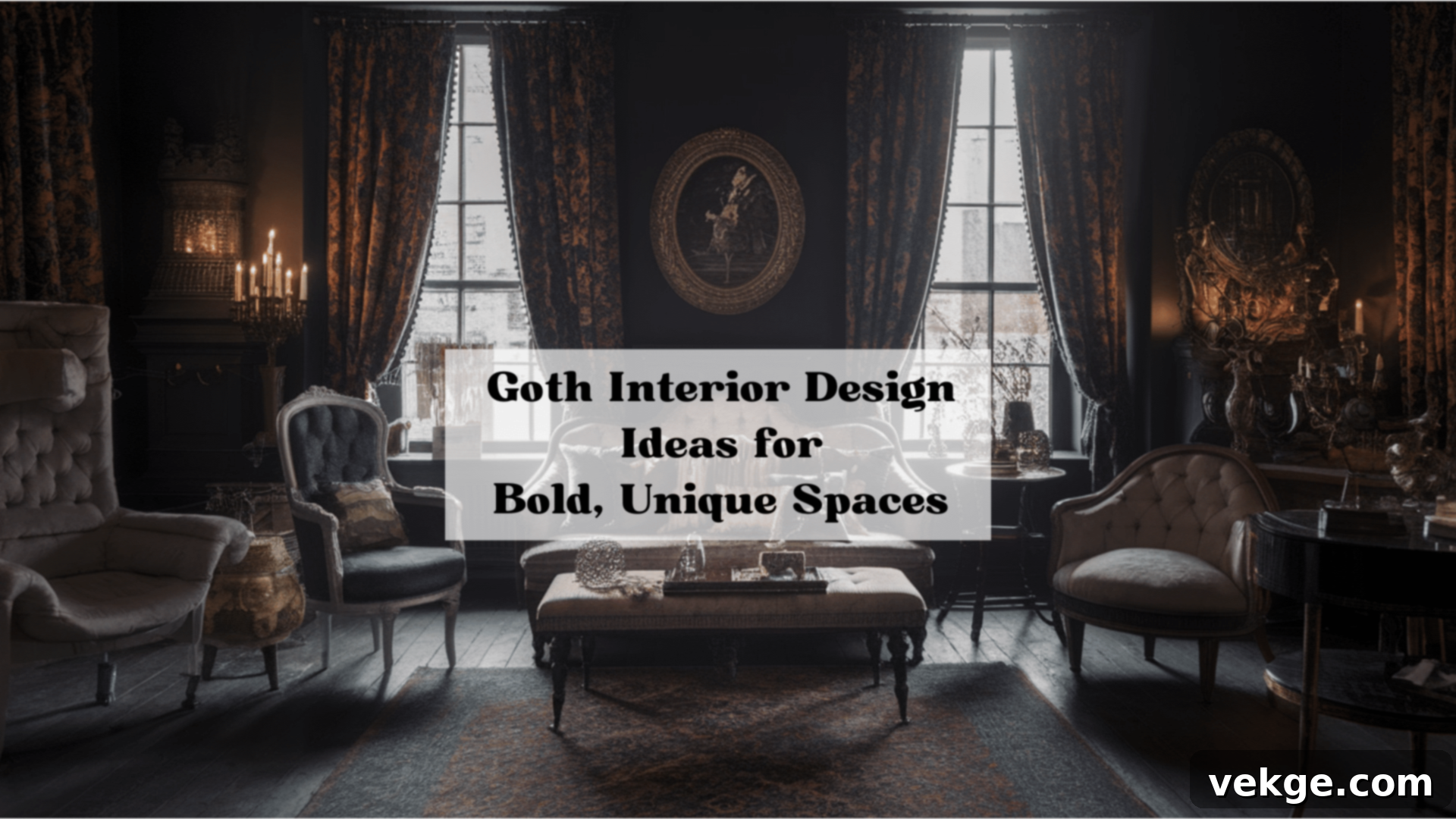Gothic Interior Design: Embrace Dark Elegance and Timeless Drama in Your Home
Gothic interior design offers a captivating journey into a world of dramatic elegance and old-world charm, transforming contemporary homes into deeply personal sanctuaries. Drawing profound inspiration from medieval aesthetics, this distinctive design philosophy masterfully blends dark, moody color palettes, bold architectural forms, and sumptuously rich textures. The result is a series of spaces that feel simultaneously grand, intimate, and profoundly inviting, a true departure from the often bright and minimalist trends of today.
Many homeowners are increasingly drawn to Gothic interiors precisely because they offer a unique narrative and a distinct sense of character, standing apart from conventional modern aesthetics. This style expertly marries historical grandeur with contemporary comfort, providing a rich canvas for individuals to express their unique tastes and sophisticated preferences through their living environments. Whether applied to expansive estates or more compact urban dwellings, Gothic design excels at creating rooms that tell compelling stories, inviting guests to pause, observe, and truly engage with the surroundings. It’s more than just decor; it’s an immersive experience that turns ordinary rooms into striking yet welcoming personal retreats.
The Enduring Allure and History of Gothic Design in Interiors
The term “Gothic” often conjures images of medieval cathedrals with soaring arches and intricate stained glass. While its origins lie in ecclesiastical architecture, the Gothic aesthetic has continually re-emerged and evolved in interior design, particularly gaining prominence during the Victorian era. This enduring appeal stems from its ability to evoke a sense of history, mystery, and profound beauty. It’s a style that speaks to a desire for depth and character, providing a stark contrast to the fleeting trends of mass-produced design. Modern interpretations of Gothic interiors skillfully reinterpret these classic elements, making them relevant and livable for today’s homes, proving that timeless elegance never truly goes out of style.
Key Elements of Gothic Interior Design: Crafting a Unique Ambiance
Achieving a truly authentic and captivating Gothic interior involves a deliberate combination of several important features. When these elements are thoughtfully integrated, they converge to create spaces that possess an unmistakable character, setting them apart from typical contemporary homes and imbuing them with a sense of historic depth and dramatic flair.
1. Dark Color Schemes and Rich Tones
The foundation of Gothic design is its reliance on deep, luxurious color palettes. Black walls, for instance, are a hallmark, creating a powerful, dramatic statement that simultaneously serves as a sophisticated backdrop for other design elements. Beyond stark black, the style frequently incorporates an array of deep jewel tones such as sumptuous burgundy, enigmatic deep purple, and rich forest green, each adding layers of opulence and visual interest. To prevent spaces from feeling overwhelmingly dark, Gothic design often employs stark contrasts: think of dark, polished wood against crisp white walls, or bold black frames exquisitely highlighting lighter-colored artworks. This interplay of light and shadow, dark and vibrant, is crucial for making each element pop and creating a dynamic visual narrative within the room.
2. Intricate Architectural Details and Structural Drama
Historically, pointed arches, elaborate ribbed vaults, and majestic tall windows were the defining architectural characteristics of grand Gothic structures. While replicating these features in a modern home might be challenging, their essence can be beautifully translated. Even in contemporary residences, the addition of decorative wood trim to simulate the graceful curve of arches, or the installation of ornate moldings and wainscoting, can powerfully evoke this historic feeling. These architectural details are not merely decorative; they serve to draw the eye upward, enhancing the perception of height and imbuing rooms with a sense of expansive grandeur and timeless elegance, reminiscent of ancient cathedrals and noble halls.
3. Gothic Furniture and Ornate Fixtures
Furniture in Gothic-inspired spaces typically features robust construction, often crafted from dark, heavy woods like oak or mahogany, and adorned with intricately carved details. Each piece often carries a palpable sense of weight, history, and craftsmanship. Key pieces to look for include chairs with imposing high backs, tables distinguished by chunky, carved legs, and cabinets embellished with decorative metal hardware, such as iron or brass. To enhance the historic atmosphere without making the space feel like a stark museum, a thoughtful mix of a few antique or vintage pieces alongside newer, Gothic-inspired items works wonders, adding authenticity and character.
4. Layered Lighting and Atmospheric Illumination
Lighting is a pivotal element in crafting the signature mood of Gothic design. Ornate chandeliers, often multi-armed and grand, serve as central focal points, casting soft pools of warm, inviting light. Table lamps adorned with stained glass shades are particularly effective, diffusing light into beautiful, colored patterns that add an ethereal quality. Wall sconces placed at eye level contribute an ambient glow, enriching the overall atmosphere. The primary objective is to create soft, warm, and layered lighting that plays with shadows and depth. This approach imbues the space with a feeling that is both immensely cozy and wonderfully mysterious, enhancing the dramatic and intimate allure of Gothic interiors.
Types of Gothic Interior Design: Exploring Diverse Interpretations
The Gothic aesthetic is far from monolithic; it encompasses several distinct sub-styles, each offering a unique take on its core principles. Understanding these variations allows for a more nuanced and personalized approach to incorporating Gothic elements into your home.
Victorian Gothic: Opulence and Romanticism
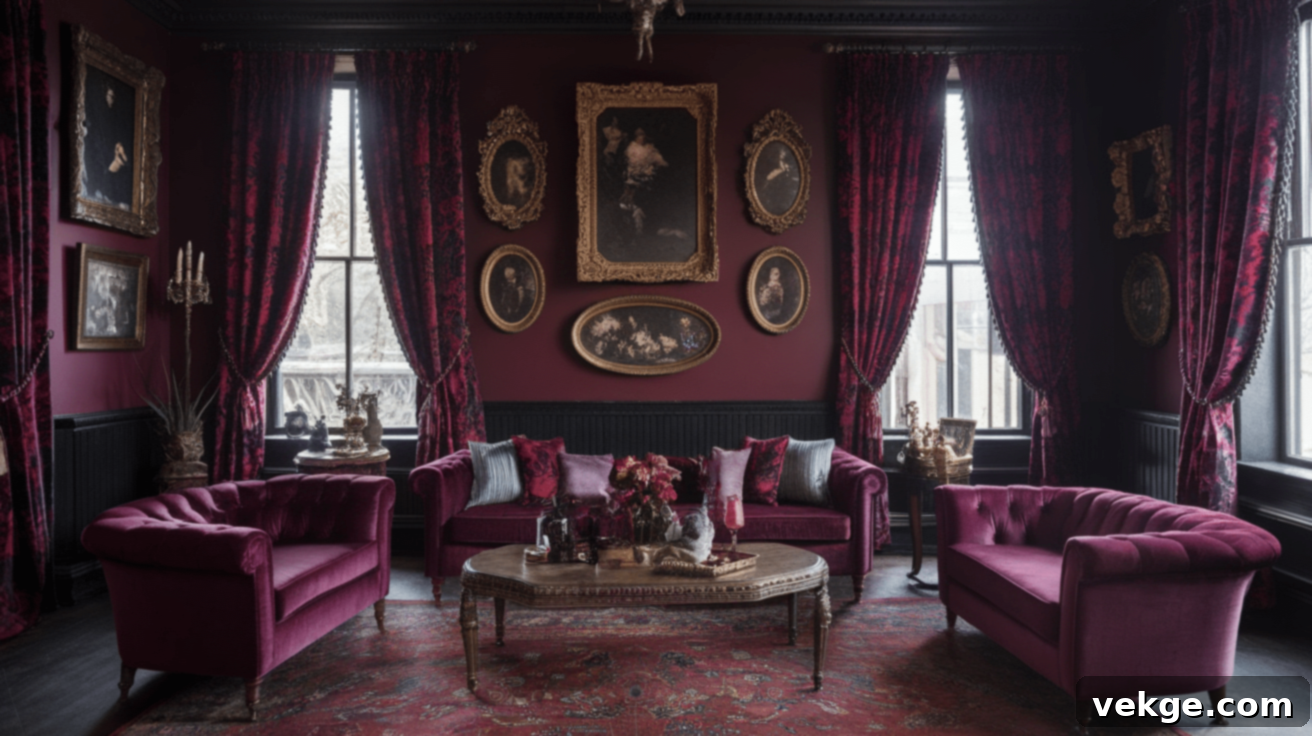
Victorian Gothic beautifully marries the dramatic, dark elements of traditional Gothic with the plush comforts and romantic sensibility characteristic of the Victorian era. This style is often recognized by its use of rich patterned wallpaper—think damask, brocade, or floral motifs—luxurious velvet upholstery, and meticulously detailed woodwork. Deep reds, rich purples, and emerald greens dominate the color palette, often paired with an abundance of collected curiosities, from taxidermy to antique globes, and ornate picture frames displaying family portraits or landscapes. Victorian Gothic spaces exude a sense of layered opulence, historical richness, and comfortable grandeur, creating a truly immersive and tactile environment.
Medieval Gothic: Raw Authenticity and Ancient Roots
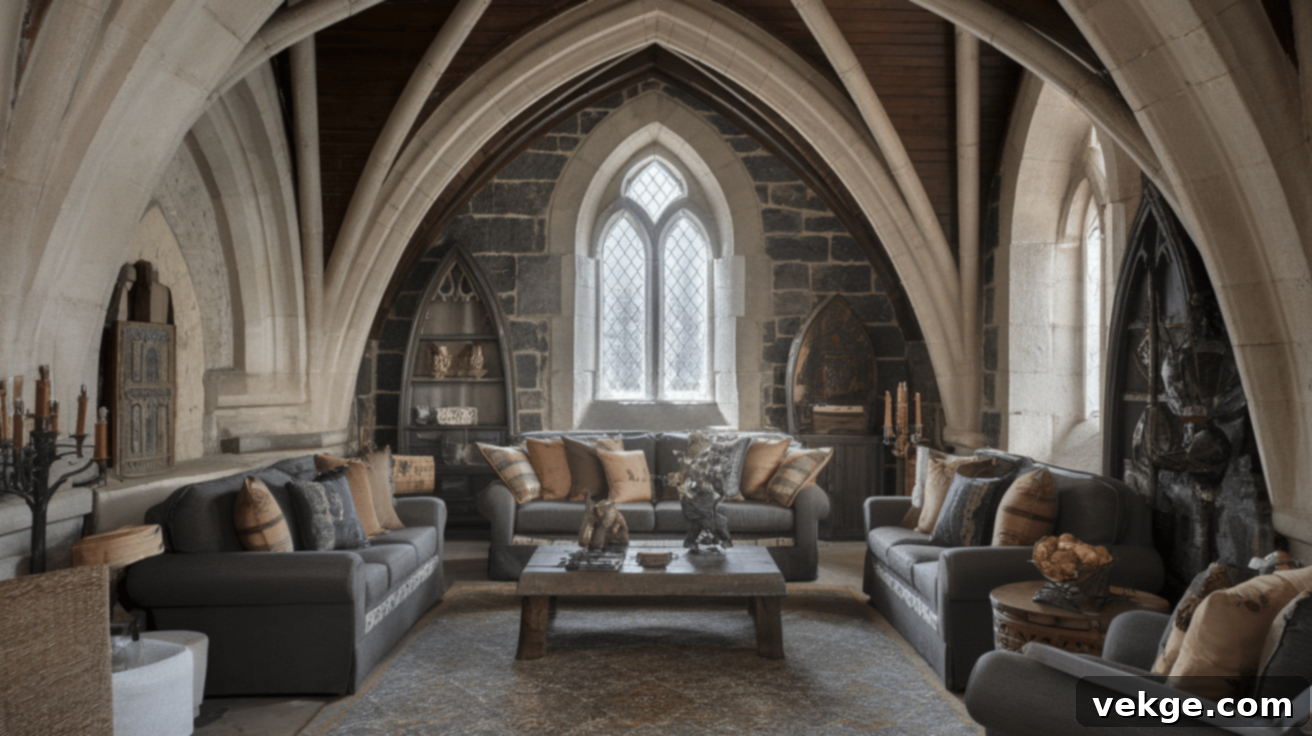
Medieval Gothic draws its inspiration directly from the formidable castles and awe-inspiring cathedrals of the Middle Ages. This iteration of the style emphasizes raw, natural materials and robust construction. Think exposed stone walls, hand-forged iron fixtures, and heavy, unyielding wooden furniture that collectively create a sturdy, timeless, and almost austere feel. The color scheme often revolves around earthy tones, complemented by deep blues, forest greens, and rich reds, reminiscent of heraldic colors. Arched doorways, exposed ceiling beams, and wall hangings that mimic ancient tapestries complete this authentic, historical look, transporting inhabitants back to an era of knights and kings.
Modern Gothic: Sleek Drama and Contemporary Edge
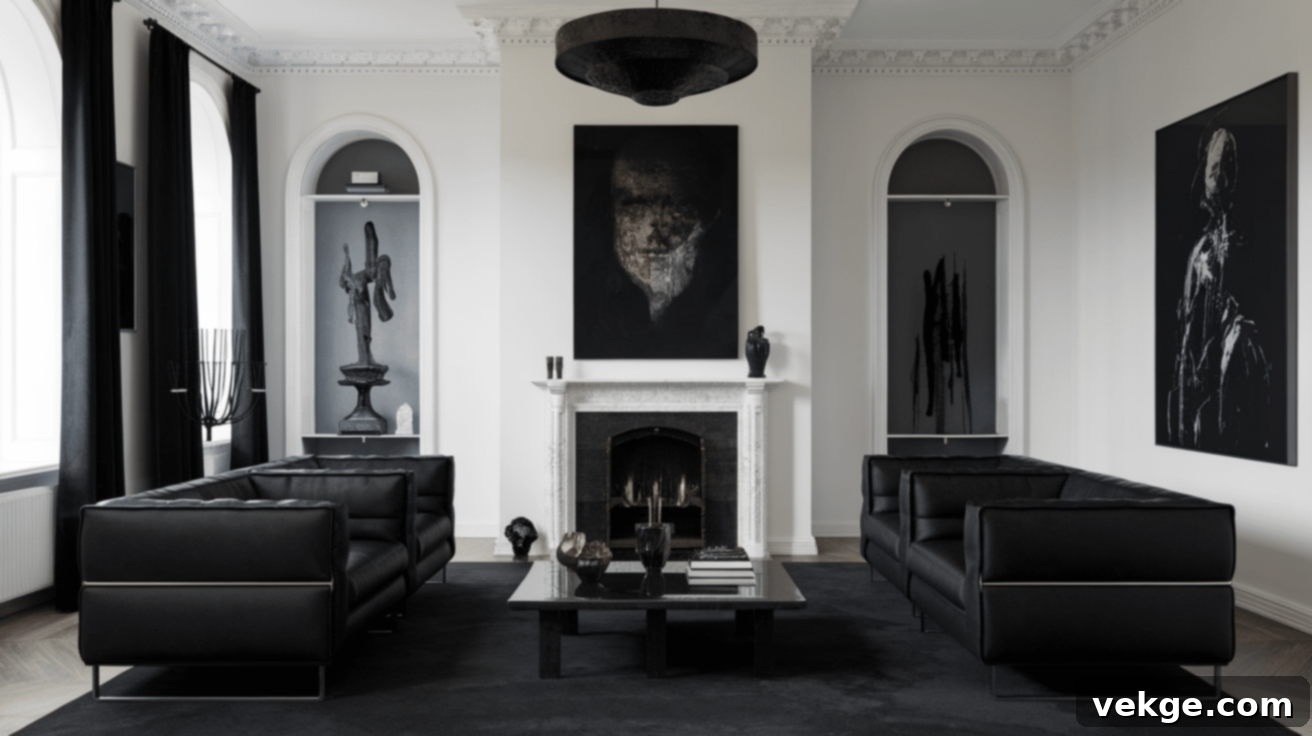
Modern Gothic offers a sophisticated fusion of the dramatic mood inherent in Gothic design with the clean, minimalist lines of contemporary aesthetics. This approach typically features sleek black furniture with simplified forms, which are then punctuated by carefully selected Gothic touches like a dramatic statement chandelier, a piece of dark, provocative art, or a textured wall. The palette tends to be more monochromatic, focusing on blacks, grays, and whites, with perhaps one or two deep accent colors. This interpretation maintains a current, fresh feel while adding depth and character through judicious use of color, texture, and carefully chosen accent pieces. Modern Gothic is particularly well-suited for urban apartments, lofts, and newer homes where historical architectural details are absent but a desire for a unique, moody ambiance prevails.
How to Achieve a Gothic Look in Your Home: Room-by-Room Guide
Implementing Gothic design doesn’t mean transforming your entire home into a medieval castle. Here are practical and actionable ways to introduce Gothic elements into different rooms, ensuring they remain livable, comfortable, and distinctly stylish.
Gothic Bedroom Design: A Cozy and Dramatic Retreat

The bedroom is an ideal canvas for the Gothic style, as this aesthetic naturally fosters a cozy, nest-like, and deeply comforting atmosphere. Begin by painting walls in rich, enveloping colors such as charcoal gray, deep navy, or eggplant. Install heavy, opulent curtains, preferably velvet or brocade, that completely block out light, ensuring both dramatic flair and superior sleep quality. Choose a bed frame with an imposing, tall headboard, or consider adding a canopy frame for an undeniable sense of drama and enclosure. Layer bedding generously with different luxurious textures—think soft velvet, crisp cotton, smooth satin, and rich brocade—to achieve maximum richness and comfort. Complete this sanctuary with wall sconces that cast a soft, warm glow, and a vintage-style area rug to add warmth and character to wooden floors. Don’t forget scented candles or diffusers with earthy, musky notes to enhance the sensory experience.
Gothic Living Room: A Blend of History and Comfort
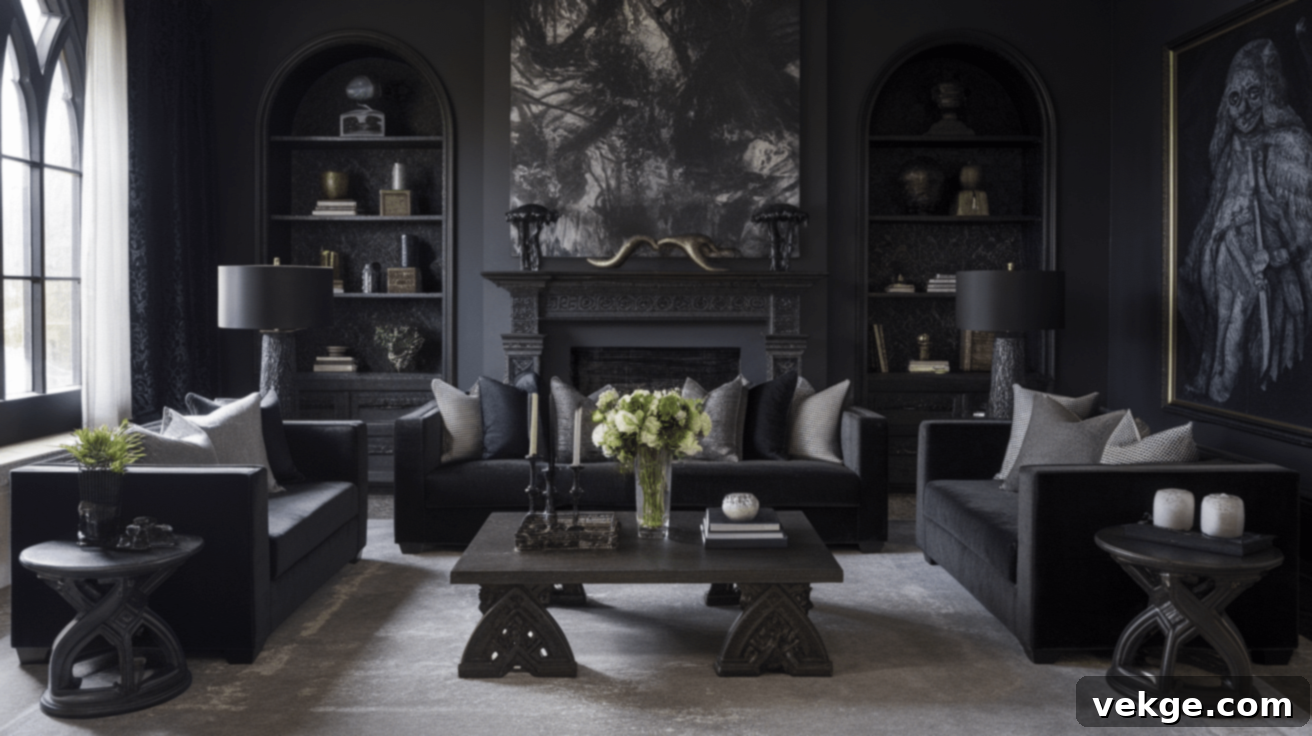
In the living room, the key is to artfully blend old-world charm with modern functionality to create a Gothic space that remains practical and inviting. A contemporary sofa in a deep black or dark gray provides essential comfort while perfectly aligning with the somber color scheme. Introduce character with carved wooden side tables, or repurpose an antique chest as a unique coffee table. Display a curated collection of books with dark, intriguing covers, and group an assortment of candles on elegant trays for enchanting evening lighting. Wall art can range from ancient maps and evocative black-and-white photographs to mirrors encased in ornate, gilded frames. A tall bookcase with glass doors offers a perfect stage to showcase beloved collections, adding intellectual depth to the room.
Gothic Bathroom Design: Unexpected Elegance and Mood
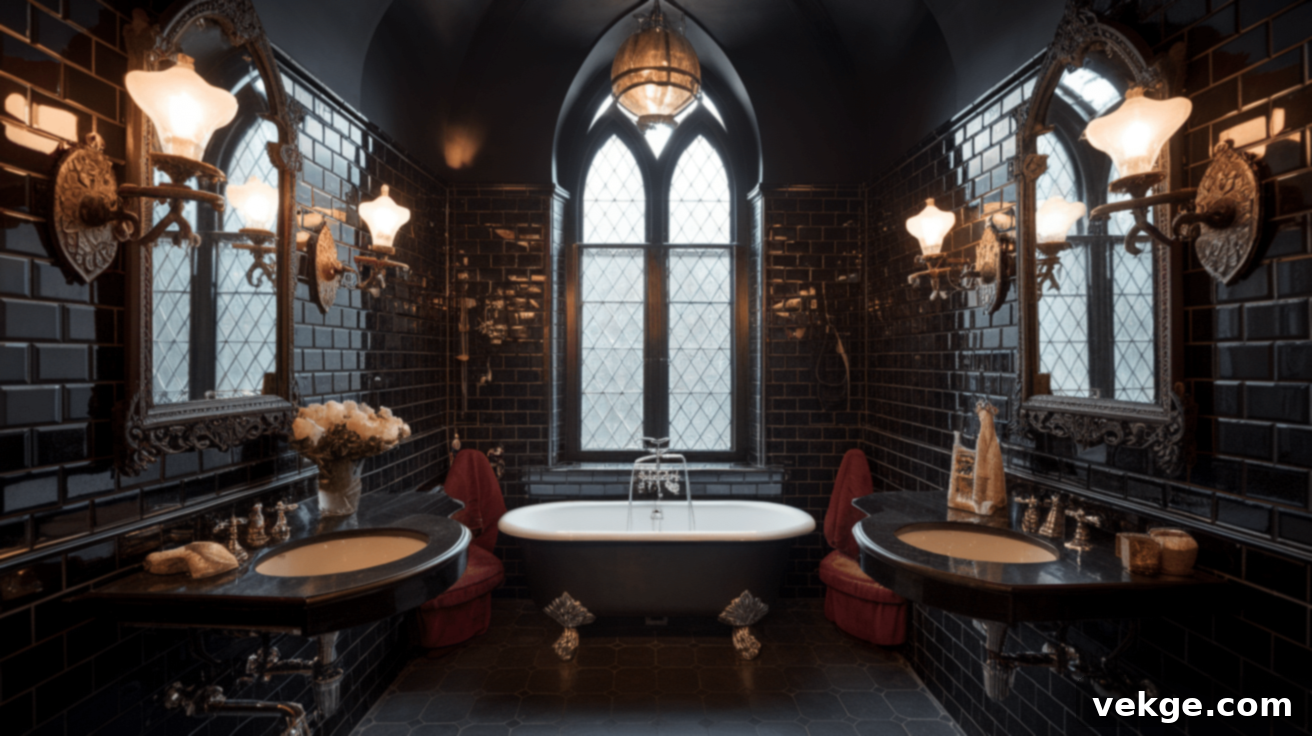
The bathroom, often overlooked, presents excellent opportunities for infusing Gothic style. Opt for dark tiles on floors or shower walls—matte black, deep green, or navy blue work exceptionally well to create a sophisticated, moody backdrop. Above the sink, install a mirror with an exquisitely ornate frame, perhaps in dark wood or a tarnished metallic finish. Wall-mounted light fixtures with frosted or colored glass shades will cast a gentle, diffused light, enhancing the atmospheric quality. Even smaller bathrooms can embrace the Gothic aesthetic with dark, plush towels, a richly colored or velvet shower curtain, and a few carefully chosen decorative items, such as a vintage tray for toiletries or a small stained-glass window hanging that diffuses light with a mystical glow. Consider a dark, freestanding vanity for a truly grand statement.
Tips for Balancing Gothic Style with Modern Living
While Gothic style can undeniably create breathtakingly stunning homes, it requires careful balance to ensure the spaces remain livable, comfortable, and welcoming. The inherent drama of dark colors and heavy furniture can sometimes overwhelm a room, making it feel oppressive rather than inviting. The secret lies in finding the perfect equilibrium between dramatic impact and everyday comfort within your home.
- Introduce Lighter Elements: To prevent overwhelming darkness, ensure at least one significant element in the room remains light. This could be pristine white or cream trim around windows and doors, a light-colored area rug, sheer white curtains layered under heavy drapes, or even light-colored ceiling treatments.
- Strategic Mirror Placement: Mirrors are invaluable for reflecting natural light, effectively brightening and expanding the perception of space in darker rooms. Choose mirrors with ornate, Gothic-inspired frames to enhance the aesthetic while serving a functional purpose.
- Incorporate Metallic Accents: Introduce metallic elements like brass, copper, silver, or aged gold through picture frames, light fixtures, decorative objects, or even furniture hardware. These reflective surfaces catch and bounce light, adding sparkle and preventing the room from feeling flat.
- Utilize Accent Walls: Instead of painting all walls dark, consider designating one focal wall for a deep, rich color or a patterned wallpaper. The remaining walls can be painted in a lighter, complementary shade to maintain an open feel.
- Balance Furniture Upholstery: If your furniture frames are dark and heavy, opt for lighter-colored upholstery on sofas and chairs. Cream, light gray, or even subtle patterns can provide a visual break and a sense of softness.
- Add Greenery and Plants: Living plants, especially those with dark, glossy leaves, bring a crucial element of life, softness, and natural color into a Gothic space, counteracting potential somberness. Large potted ferns or snake plants can thrive in lower light conditions and contribute to the atmosphere.
- Layer Textures Extensively: The rich tactile experience is a hallmark of Gothic design. Layer different fabrics like velvet, silk, brocade, faux fur, and linen in throws, pillows, and curtains to add depth and warmth without relying solely on dark colors.
What to Avoid in Gothic Interior Design: Maintaining Balance and Light
While dark colors are foundational to the Gothic style, an excessive application can inadvertently make rooms feel small, gloomy, and unwelcoming. The paramount principle in successful Gothic design is creating dynamic contrast and thoughtful balance, ensuring that the drama serves to enhance comfort rather than detract from it.
To prevent your Gothic-inspired home from feeling like a cave, avoid these common pitfalls:
- Excessive Darkness Without Contrast: Do not paint all walls in very dark shades without introducing lighter elements or reflective surfaces. The key is strategic use of dark colors, not their overwhelming dominance.
- Lack of Reflective Surfaces: Failing to incorporate mirrors, metallic accents, or glossy finishes will result in a room that absorbs all light, feeling heavy and oppressive.
- Monochromatic Dark Furniture: While dark furniture is characteristic, choosing every piece in the exact same dark tone (e.g., all black) can make a room feel flat and uninviting. Vary the shades of dark wood or introduce different upholstery colors.
- Neglecting Layered Lighting: Relying on a single overhead light source in a dark room will create harsh shadows and an uninviting atmosphere. Instead, always layer lighting from multiple sources and heights.
- Ignoring Texture: A lack of varied textures (velvet, silk, leather, rough stone, polished wood) can make a dark space feel flat and uninteresting. Texture adds depth and visual appeal.
- Too Many Ornate Elements: While intricate details are important, over-decorating with too many highly ornate pieces can lead to a cluttered and overwhelming look, especially in smaller spaces. Select key statement pieces.
- Forgetting Natural Elements: Overlooking the inclusion of living plants or natural wood finishes can make a space feel cold and artificial. Greenery adds life and softness.
- Dark Floors with Dark Walls: If both your walls and major furniture pieces are very dark, consider lighter floors (e.g., light wood, stone, or a pale rug) to prevent the room from feeling completely enclosed and heavy.
These techniques are crucial for maintaining the intended Gothic mood—one of drama and sophisticated mystery—while ensuring spaces feel open, welcoming, and elegant, rather than claustrophobic. The goal is the masterful play of light and shadow, the richness of contrast, and not merely darkness for its own sake.
Conclusion: Crafting Your Own Gothic Narrative
Gothic interior design offers an exceptionally bold and unique avenue to make your home truly stand out, imbuing it with unparalleled character and a profound sense of history. By thoughtfully focusing on deep, rich colors balanced with strategic touches of light, incorporating detailed and substantial furniture, and employing soft, layered lighting, you can successfully create rooms that tell a compelling story and exude an undeniable personality. It’s imperative to remember the importance of balancing darker elements with lighter, more reflective touches to ensure your spaces remain inviting and comfortable, not just dramatically beautiful.
Whether your preference leans towards the opulent romance of Victorian Gothic, the raw authenticity of Medieval Gothic, or the sleek, contemporary edge of Modern Gothic, this versatile style provides ample room for personal expression and creative interpretation. Don’t feel pressured to transform everything at once; start small by introducing a few key Gothic pieces or a moody color palette in a single room, then gradually expand as your comfort and vision evolve. Ultimately, the most successful Gothic spaces are those that authentically reflect your personal narrative and unique style, while paying homage to this truly timeless and captivating design approach.
